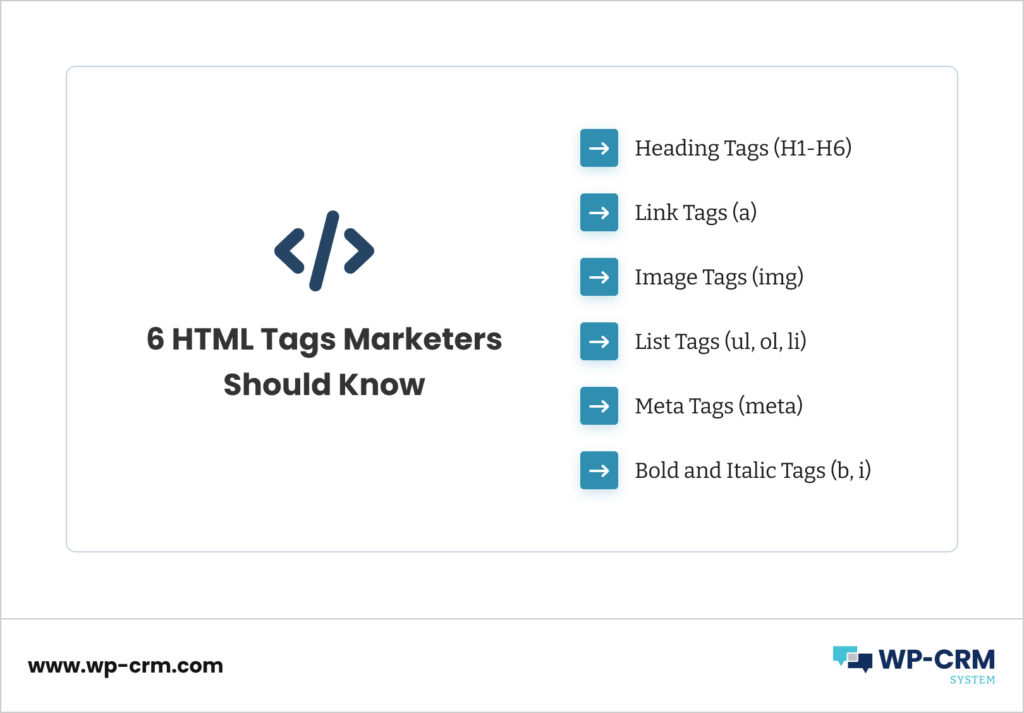6 HTML Tags Marketers Should Know
Although a deep understanding of coding is not a must for marketers, one thing is true. The easiest your web pages are to crawl, the better your online visibility, rankings and user experience. HTML tags define the relevance of a web page and its structure, and are therefore crucial for successful SEO.
HTML (HyperText Markup Language) is the backbone of web development, playing a pivotal role in creating and structuring web pages. Its significance extends far beyond coding, as it serves as the language that browsers interpret to display content on the internet.
In digital marketing, understanding HTML is not just a technical skill but a strategic asset. It empowers marketers to optimize online content for search engines, enhance user experience, and ensure accessibility. In essence, HTML is the foundation upon which effective digital marketing strategies are built. Despite the fact that only 0.5% of the world’s population knows how to code, some basic knowledge of the elements of website structure is necessary if you want to do well online.
In this article, we will explore the essential HTML tags marketers should be familiar with, emphasizing their practical application and best practices to navigate the ever-evolving landscape of online promotion.
What Is HTML?
HTML, or HyperText Markup Language, is the bedrock of web development, providing the essential structure for creating and organizing content on the internet.
At its core, HTML employs a system of tags, attributes, and elements to define the various components of a webpage. Tags act as instructions, delineating the beginning and end of elements, while attributes offer additional information about elements.
Elements, in turn, encapsulate the actual content, ranging from text to multimedia. In the vast landscape of web development, HTML plays a crucial role, acting as the universal language understood by browsers to render and display content.
6 HTML Tags Marketers Should Know: Basics & Best Practices

In the vast world of digital marketing, understanding the basics of HTML and the crucial tags associated with it can significantly impact the effectiveness of online content. Here, we explore a selection of essential HTML tags that every marketer should be well-acquainted with, delving into how these tags can be leveraged effectively to enhance SEO and ensure accessibility.
1. Heading Tags (H1-H6)
Header tags are vital for structuring content hierarchically. The <h1> tag signifies the main heading of a page, followed by <h2> for subheadings, and so forth. These tags not only contribute to a page’s visual hierarchy but also carry weight in SEO. For instance:
<h1>Main Heading</h1>
<h2>Subheading</h2>
Best Practices. Ensure a logical hierarchy that reflects the importance of each heading, aiding both users and search engines in understanding the structure of your content.
2. Link Tags (a)
The <a> tag is the anchor for creating hyperlinks. It plays a pivotal role in connecting web pages and guiding users through a seamless navigation experience. Consider the following example:
<a href="https://example.com">Visit our Website</a>Best Practices. Use descriptive anchor text to enhance SEO, and ensure links are relevant and lead to valuable content for the user.
3. Image Tags (img)
Images are powerful visual elements, and the <img> tag allows marketers to embed them within web pages. Providing an alternative text with the alt attribute is crucial for both SEO and accessibility:
<img src="image.jpg" alt="Description of Image">Best Practices. Optimize image sizes for faster page loading, and always include descriptive alt text.
4. List Tags (ul, ol, li)
HTML provides tags for creating both unordered (<ul>) and ordered (<ol>) lists, with list items designated by the <li> tag. Lists aid in organizing and presenting information in a structured manner:
<ul>
<li>Item 1</li>
<li>Item 2</li>
</ul>
Best Practice. Use lists to enhance content readability and structure information logically.
5. Meta Tags (meta)
Meta tags provide metadata about the HTML document, influencing how a webpage is displayed in search engine results. The following example demonstrates a meta description:
<meta name="description" content="Brief page description">Best Practices. Craft concise and compelling meta descriptions, incorporating relevant keywords to improve search engine visibility.
6. Bold and Italic Tags (b, i)
The <b> and <i> tags are used to emphasize text through bold and italic formatting, respectively:
<b>Bold Text</b>
<i>Italic Text</i>
Best Practices. Employ these tags sparingly for emphasis, avoiding overuse that may dilute their impact on the overall content.
Conclusion
In conclusion, a solid understanding of HTML and its key tags is indispensable for digital marketers. HTML serves as the foundation for web development, providing the essential structure for online content. Marketers who master crucial tags such as headers, links, images, lists, meta, bold, and italic gain a strategic edge. By implementing best practices, including optimizing for SEO and ensuring accessibility, these professionals can create content that not only captivates audiences but also aligns seamlessly with evolving digital trends. As the digital landscape evolves, HTML proficiency remains a valuable asset for crafting compelling and effective online marketing strategies.
